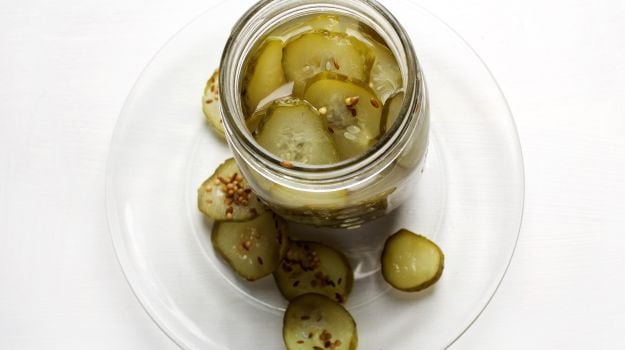Photo Credit: The Washington PostAfter years of over- and underestimating, I finally know how many quarts of tomatoes we'll use in the course of a year. I've learned to double up on the raspberry jam. Even the most delicious peach preserves go partly uneaten, but we'll finish all the peach pie filling. Seven different chutneys could be too many.
Those are among the lessons learned. Beyond preserving's seasonal time crunches - sour cherries are here and gone! - it's important to be organized and tactical, and to put up only what you'll eat or give away before it expires.
Once I have my wish list for the summer's planned canning, I strategize at the farmers markets, too. I talk with producers about the food they're growing, about the harvest, the weather, pests. Such chats inform my preserving plans. When a farmer can tell me exactly when his raspberries will be ready for picking, I block out the closest weekend day to make jam. When possible, I email ahead to place an order; the farmers I buy from appreciate that.
When I had a garden, my first tomato of the season was sliced with religious fervor, salted and consumed. Still warm from the sun, it was my private treasure. Later, faced with baskets of home-grown specimens, I became more generous. So many tomatoes!
The farmers at your local markets experience something similar, but writ large. By mid-season, their stalls are chock-full. So that's the best time to shop around for gluts, seconds and imperfect fruits and vegetables at reduced prices.
Buy in quantity whenever possible. Learn to think in pounds, flats, boxes and lugs. I purchase in quantities based on specific recipes and have committed those amounts to memory: 3 pounds of fruit for jam, 5 pounds of vegetables for pickles, never less than 25 pounds of tomatoes at a time.
If you can get out of the city, you can find better deals. In rural areas, farm stands and pick-your-own farms can offer even greater values. Grab some friends and go picking. Speaking from experience, it's remarkable how quickly three people can pick 45 pounds of blueberries.
Remember, preserving goes beyond canning. Freezing is an excellent way to store foods for winter, as is dehydrating. Whichever technique you choose, the effort takes time and money, so put up only foods you love and foods you will share with your family and friends.
In the meantime, give the accompanying recipe a try. It makes dependable dill pickle chips that are crisp, bright, sassy and ready for your summer cookouts. Make this the summer you put at least one home-canned food in your cupboard.
'Hamburger' Dill Pickle Chips:4 pints
These vinegar-brined pickles are crisp and tangy, and stack on a burger just like they should. Use a mandoline to cut the best-looking, slimmest chips. The glory of these pickles doesn't end with the chip. When the snappy pickles are gone, there's always a Pickleback: a shot of pickle brine served with a shot of whiskey.
Only pickling cucumbers, often called Kirbys, will work in this recipe.
You'll need a mandoline; a bubbler (or non-metallic knife); a tall, deep pot with a rack; and four 1-pint jars with new lids and rings; see NOTE, below.
MAKE AHEAD: The cucumbers need to brine for 8 hours. The pickles need to cure in a cool, dark spot for 1 month. They can be stored at room temperature for up to 1 year. Refrigerate after opening.
Ingredients:
50 grams (about 3 1/2 tablespoons) kosher salt
11 cups cold water (nonchlorinated)
2 pounds pickling cucumbers (see headnote)
4 stems fresh dill, preferably with seed heads (may substitute 2 tablespoons dill seed)
2 teaspoons yellow mustard seed
2 cups distilled white vinegar
4 cloves garlic, root ends trimmed
Steps:
Combine half of the salt and 8 cups of the water in a large glass or ceramic bowl. Stir well to dissolve. Add the whole cucumbers, and place a plate on top of them to keep them submerged. Brine in a cool spot for 8 hours.
Drain and rinse the cucumbers; dispose of the brine. Remove and dispose of a small slice from both ends of each cucumber. Use a mandoline, or a very sharp knife and a steady hand to slice the cucumbers 1/8-inch thick. Divide the cucumber slices among the four jars. Divide the dill and mustard seed among the jars.
Bring the remaining salt, the remaining 3 cups of water, the vinegar and the garlic cloves to a boil in a 3-quart nonreactive pot over medium-high heat. Pour the hot brine over the cucumber slices, adding one garlic clove to each jar and leaving 1-2 inch of head space. You may have brine left over; dispose of it.
Run a bubbler, chopstick or non-metal knife around the inside of the jar to remove the air bubbles from the brine. Clean each jar rim with a damp paper towel, place the lids and rings on the jars, and finger-tighten the rings. Process in a boiling-water bath for 10 minutes.
Lift the jars from the boiling water, keeping them upright, and place them on a folded towel. Let them cool for several hours, then remove the rings, test the seals and wash the jars well before labeling. Let the pickles cure in a cool, dark spot for 1 month. Chill thoroughly before serving.
NOTE: Water-bath canning safely seals high-acid, low-pH foods in jars. The time for processing in the water bath is calculated based on the size of the jar and the consistency and density of the food. For safety's sake, do not alter the jar size, ingredients, ratios or processing time in any canning recipe. If moved to change any of those factors, simply put the prepared food in the refrigerator and eat within a month.
Ingredients are too variable for a meaningful analysis.
(c) 2016, The Washington Post(This story has not been edited by NDTV staff and is auto-generated from a syndicated feed.)






